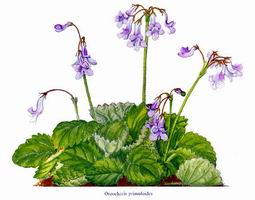
Bot. Mag., n.s., 47 (1949), as Oreocharis primuloides Miq.
Full name and orig. publication: Opithandra B.L.Burtt, Baileya 4: 162 (28 Dec. 1956).
Etymology: From the Greek όπιθη, opithē = behind, rear, and ανηρ, ανδρος, anēr, andros = male, in allusion to the fact that the posterior stamens are the fertile ones.
Synonyms: Schistolobos W.T.Wang (1992).
Infrafamilial position: Didymocarpoid Gesneriaceae - "Advanced Asiatic and Malesian genera" (Weber 2004).
Description: Subacaulescent rosette plants. Leaves alternate, rosulate or in a dense rosette, petiolate, pilose or pilose-pubescent on both surfaces or densely pannose on petiole and lower lamina surface (at least at veins). Cymes axillary, peduncles longer than leaves, one- to several-flowered, bracteoles small. Sepals free to base, lanceolate. Corolla pink to purple, tube of variable length, limb subregular or bilabiate, lobes porrect or patent. Fertile stamens 2, the posterior pair; filaments straight or slightly curved; anthers free or apically slightly coherent, oblong or subglobose, thecae originally not confluent. Nectary low, cup-shaped. Ovary cylindrical, tapering into style; stigma deeply bilobed or small, pointed or puncticulate. Fruit a capsule, dehiscing loculicidally to base.
Chromosome number: 2n = 34.
Species number: 10.
Species names (incl. publication and synonyms): See Skog, L.E. & J.K. Boggan. 2005: World checklist of Gesneriaceae: http://persoon.si.edu/Gesneriaceae/Checklist.
Type species: Opithandra primuloides (Miq.) B.L.Burtt
Distribution: S China (Sichuan, Guangxi, Guangdong, Jiangxi, Fujian, W Hunan, Guizhou), Japan (type sp.).
Ecology: Growing (in China) on streamside rocks or shaded areas in montane forests, 500-900 m.
Notes: The distinctive feature of the genus is the reduction or abortion of the anterior (lower) stamen pair. In all other diandrous species of Didymocarpoid Gesneriaceae it is the posterior (upper pair) which is reduced. Nevertheless, convergence in the reduction of the anterior pair cannot be excluded, and it may be that some Chinese species can be more closely associated with tetrandrous genera such as Briggsia or Oreocharis (see Burtt 1958). Wang & al. (1990) refer the species to four sections:
(1) sect. Opithandra,
(2) sect. Microstigma W.T.Wang,
(3) sect. Stenosiphon W.T.Wang,
4) sect. Briggsioides W.T.Wang.
Selected references: Burtt, Notes Roy. Bot. Gard. Edinburgh 22: 303 (1958), prov. rev.; Wang, Bull. Bot. Res., Harbin, 7: 1 (1987); Wang et al. in Wu & Raven (eds.), Fl. China 18: 289-291 (1998) (Chinese spp.).
Bibliography: See Skog, L.E. & J.K. Boggan. 2005. Bibliography of the Gesneriaceae. 2nd edition: http://persoon.si.edu/Gesneriaceae/Bibliography.
Illustrations:
 |
Opithandra primuloides (Miq.) B.L.Burtt, type species Bot. Mag., n.s., 47 (1949), as Oreocharis primuloides Miq. |
last modified: 2007-01-05